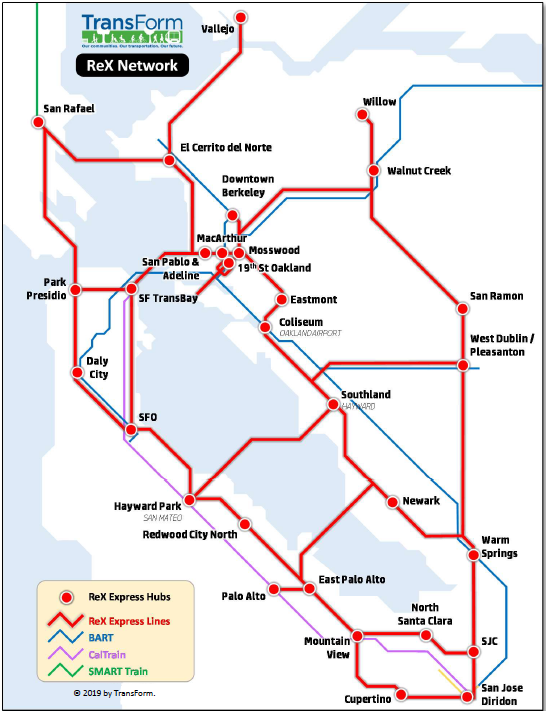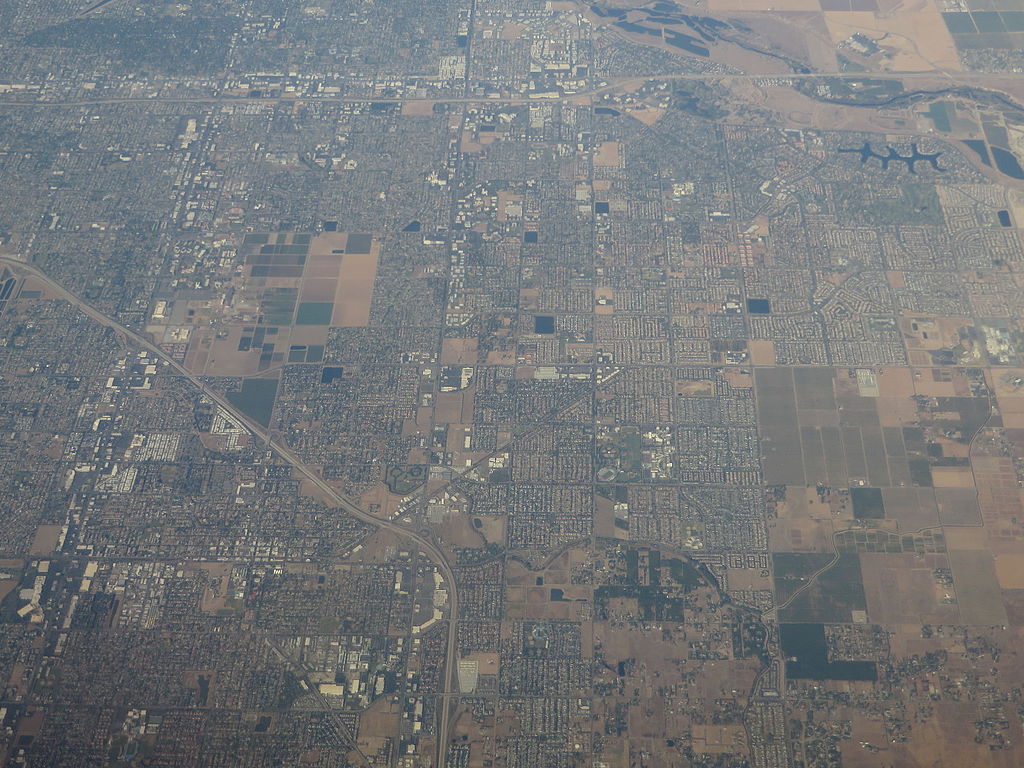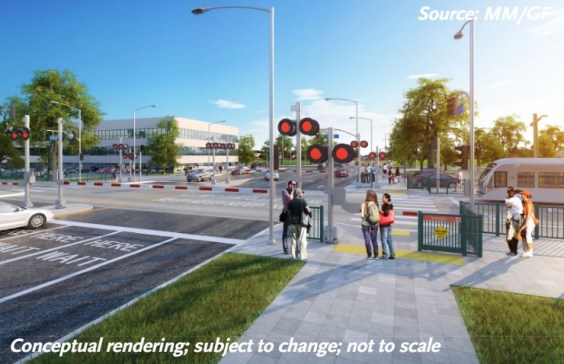The Bay Area has a robust public transit system, with more than 25 local transit agencies, including several regional rail systems. But the system has gaping holes in it, and crossing the region using transit can be anywhere from extremely time-consuming to impossible.
TransForm has been working on an idea to make it quick, convenient, and easy to get around the region via transit, offering better-than-decent alternatives to driving. Its vision, called the Regional Express Transit Network, or ReX, is an idea for a new system of "rail-like rubber-tire transit" using managed lanes on area freeways.
TransForm has mapped out potential hubs for the regional system, which would connect to existing regional rail and local transit routes. The idea is to get people from hub to hub faster than driving, with convenient, frequent connections to existing and enhanced local transit at the hubs.
To be clear: this is a vision for the future, set out in some detail by TransForm but with a lot more work to be done. The organization has released it now to provide input to the Metropolitan Transportation Commission (MTC) on work it is currently doing to model a proposed network of managed freeway lanes. It also lays out potential investments from a future regional transportation tax measure. It's a roadmap of how transportation investments could be used to improve transit and provide alternatives to driving throughout the region.
"We would expect ReX to increase ridership across the board," said Edie Irons, TransForm's Communications Director. "We see it as connecting and complementing existing systems, making transit a more convenient and attractive option for lots of people who don't currently use transit. It's a regional transit option with a greater reach than currently exists."
"We know people are commuting across county lines, traveling greater and greater distances; that's what is jamming our highways and wasting people's hours in traffic. At the same time, we have lots of great local transit, but we need more regional connections and a way to get people longer distances faster."
By taking advantage of existing planned "managed lanes" already being added to Bay Area freeways, costs could be kept relatively low for high-quality transit. Transit is also a more efficient use of managed lanes, which add capacity to freeways but can encourage more driving. Also, since solo drivers can pay a toll to drive in the lanes, any speed advantage for transit could quickly disappear. That's where the "managed" piece becomes critical. ReX would rely on dynamic tolling to keep the lanes from becoming as jammed as nearby travel lanes.
"The idea is to keep the flow of traffic at 45 mph or greater and for transit to be able to get out of traffic congestion," said Irons.
“As the Bay Area builds and connects more express lanes around the region, we’re creating a huge opportunity to move more people more quickly with fewer cars," according to Arielle Fleisher, transportation policy director for the San Francisco Bay Area Planning and Urban Research Association (SPUR). "ReX would make excellent use of a complete express lane network, which is already taking shape on the 680, 580, and 880 freeways.”
The vision, though detailed in some aspects, leaves lots for planners to grapple with. For example, what is the best way to design and create stations for passengers without unnecessarily slowing down transit by forcing it to exit freeways? (One partial answer: not via stations in freeway medians). How would it coordinate with local transit? Administrative issues, as well as who would run the system, remain for future discussions.
One detail it insists on is ensuring that ReX is as much like rail as possible, especially from the perspective of its riders. That would mean things like high frequency, separation from traffic congestion, and stations structured to protect riders from the elements.
The proposal goes into some detail about where hubs would be best located, why those locations are key, and how best to get ReX to them. For example, downtown Berkeley is a major job hub, but it's not near a freeway. The ReX vision proposes a subway between downtown Oakland and downtown Berkeley to get around that. There's another subway proposed for Palo Alto and Stanford. Flyovers and freeway connectors would be necessary to supplement the planned managed lane network.
It's a giant, future vision for what transit could be like, and its main contribution may be as a framework for thinking about how transportation revenue should be spent. For years, California has invested in transportation infrastructure - roads and highways - for cars. The Bay Area has invested heavily as well in transit, but its regional rail systems remain piecemeal and unconnected. What is the best, most efficient way to spend future transportation revenue?
To prevent complete destruction of the environment and air quality, not to mention the health problems associated with the stress of long commutes, we know Californians need to drive less. We need alternatives, and those alternatives are not going to appear out of thin air. "We want revenue going to transit, to high-occupancy modes, to walking and biking infrastructure; to things that will get people out of cars, reduce emissions, and fit affordability measures," said Irons.
The hope is that a system like ReX would provide a range of benefits including efficient use of funding, more transit capacity, equitable transit for all users, cleaner environmental outcomes, and encouragement for housing development near transit-rich hubs to reduce the need for longer and longer travel.
Advocates for issue from equity to youth see promise in the vision. “ReX could save a lot of people serious time and money, including low-income people of color who are struggling with traffic, lack of quality transportation options, and the high cost of living," according to Bob Allen, Urban Habitat's director of policy. "This proposal could provide relief for families and working people who have been displaced further away from jobs and quality transit in the Bay Area.” Eduardo Gonzalez, program manager in San Mateo County for Youth Leadership Institute, points out that the ReX vision could make a big difference for youth, connecting them easily to resources around the Bay Area.
Unanswered questions remain, including costs, legislation that might be needed, governance, and standards for things such as stations and vehicles. TransForm did a lot of work around estimating travel times, but those would be subject to many unknown future variables including population, jobs and housing balance, and the success of other efforts to provide alternatives to driving.
ReX was one of twelve project ideas chosen for more analysis from among hundreds submitted to the MTC for its Horizon Initiative. The MTC will include these analyses in its planning and modeling for future iterations of Plan Bay Area, the region’s long-range plan for transportation, land use, economic development, and resilience. Plan Bay Area 2050 is slated for completion in 2021.
Take a look at the 200+ page TransForm report here.





